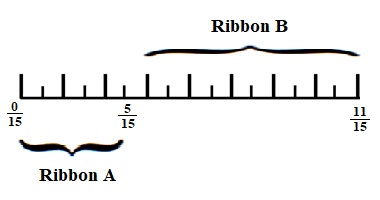Engage NY Eureka Math 5th Grade Module 3 Lesson 7 Answer Key
Eureka Math Grade 5 Module 3 Lesson 7 Sprint Answer Key
A
Circle the Equivalent Fraction
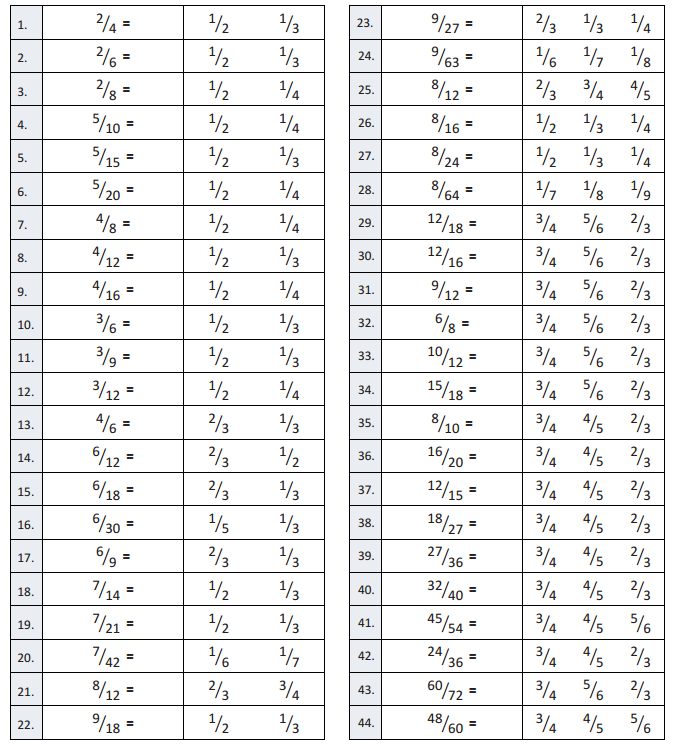
Question 1.
\(\frac{2}{4}\) = \(\frac{1}{2}\) \(\frac{1}{3}\)
Answer:
\(\frac{2}{4}\) = \(\frac{1}{2}\)
Explanation :
\(\frac{2}{4}\) when its numerator and denominator is divided by 2 we get \(\frac{1}{2}\)
Question 2.
\(\frac{2}{6}\) = \(\frac{1}{2}\) \(\frac{1}{3}\)
Answer:
\(\frac{2}{6}\) = \(\frac{1}{3}\)
Explanation :
\(\frac{2}{6}\) when its numerator and denominator is divided by 2 we get \(\frac{1}{3}\)
Question 3.
\(\frac{2}{8}\) = \(\frac{1}{2}\) \(\frac{1}{4}\)
Answer:
\(\frac{2}{8}\) = \(\frac{1}{4}\)
Explanation :
\(\frac{2}{8}\) when its numerator and denominator is divided by 2 we get \(\frac{1}{4}\)
Question 4.
\(\frac{5}{10}\) = \(\frac{1}{2}\) \(\frac{1}{4}\)
Answer:
\(\frac{5}{10}\) = \(\frac{1}{2}\)
Explanation :
\(\frac{5}{10}\) when its numerator and denominator is divided by 5 we get \(\frac{1}{2}[/latex
Question 5.
[latex]\frac{5}{15}\) = \(\frac{1}{2}\) \(\frac{1}{3}\)
Answer:
\(\frac{5}{15}\) = \(\frac{1}{3}\)
Explanation :
\(\frac{5}{15}\) when its numerator and denominator is divided by 5 we get \(\frac{1}{3}\)
Question 6.
\(\frac{5}{20}\) = \(\frac{1}{2}\) \(\frac{1}{4}\)
Answer:
\(\frac{5}{20}\) = \(\frac{1}{4}\)
Explanation :
\(\frac{5}{20}\) when its numerator and denominator is divided by 5 we get \(\frac{1}{4}\)
Question 7.
\(\frac{4}{8}\) = \(\frac{1}{2}\) \(\frac{1}{4}\)
Answer:
\(\frac{4}{8}\) = \(\frac{1}{2}\)
Explanation :
\(\frac{4}{8}\) when its numerator and denominator is divided by 4 we get \(\frac{1}{2}\)
Question 8.
\(\frac{4}{12}\) = \(\frac{1}{2}\) \(\frac{1}{3}\)
Answer:
\(\frac{4}{12}\) = \(\frac{1}{3}\)
Explanation :
\(\frac{4}{12}\) when its numerator and denominator is divided by 4 we get \(\frac{1}{3}\)
Question 9.
\(\frac{4}{16}\) = \(\frac{1}{2}\) \(\frac{1}{4}\)
Answer:
\(\frac{4}{16}\) = \(\frac{1}{4}\)
Explanation :
\(\frac{4}{16}\) when its numerator and denominator is divided by 4 we get \(\frac{1}{4}\)
Question 10.
\(\frac{3}{6}\) = \(\frac{1}{2}\) \(\frac{1}{3}\)
Answer:
\(\frac{3}{6}\) = \(\frac{1}{2}\)
Explanation :
\(\frac{3}{6}\) when its numerator and denominator is divided by 3 we get \(\frac{1}{2}\)
Question 11.
\(\frac{3}{9}\) = \(\frac{1}{2}\) \(\frac{1}{3}\)
Answer:
\(\frac{3}{9}\) = \(\frac{1}{3}\)
Explanation :
\(\frac{3}{9}\) when its numerator and denominator is divided by 3 we get \(\frac{1}{3}\)
Question 12.
\(\frac{3}{12}\) = \(\frac{1}{2}\) \(\frac{1}{4}\)
Answer:
\(\frac{3}{12}\) = \(\frac{1}{4}\)
Explanation :
\(\frac{3}{12}\) when its numerator and denominator is divided by 3 we get \(\frac{1}{4}\)
Question 13.
\(\frac{4}{6}\) = \(\frac{2}{3}\) \(\frac{1}{3}\)
Answer:
\(\frac{4}{6}\) = \(\frac{2}{3}\)
Explanation :
\(\frac{4}{6}\) when its numerator and denominator is divided by 2 we get \(\frac{2}{3}\)
Question 14.
\(\frac{6}{12}\) = \(\frac{2}{3}\) \(\frac{1}{2}\)
Answer:
\(\frac{6}{12}\) = \(\frac{1}{2}\)
Explanation :
\(\frac{6}{12}\) when its numerator and denominator is divided by 6 we get \(\frac{1}{2}\)
Question 15.
\(\frac{6}{18}\) = \(\frac{2}{3}\) \(\frac{1}{3}\)
Answer:
\(\frac{6}{18}\) = \(\frac{1}{3}\)
Explanation :
\(\frac{6}{18}\) when its numerator and denominator is divided by 6 we get \(\frac{1}{3}\)
Question 16.
\(\frac{6}{30}\) = \(\frac{1}{5}\) \(\frac{1}{3}\)
Answer:
\(\frac{6}{30}\) = \(\frac{1}{5}\)
Explanation :
\(\frac{6}{30}\) when its numerator and denominator is divided by 6 we get \(\frac{1}{5}\)
Question 17.
\(\frac{6}{9}\) = \(\frac{2}{3}\) \(\frac{1}{3}\)
Answer:
\(\frac{6}{9}\) = \(\frac{2}{3}\)
Explanation :
\(\frac{6}{9}\) when its numerator and denominator is divided by 3 we get \(\frac{2}{3}\)
Question 18.
\(\frac{7}{14}\) = \(\frac{1}{2}\) \(\frac{1}{3}\)
Answer:
\(\frac{7}{14}\) = \(\frac{1}{2}\)
Explanation :
\(\frac{7}{14}\) when its numerator and denominator is divided by 7 we get \(\frac{1}{2}\)
Question 19.
\(\frac{7}{21}\) = \(\frac{1}{2}\) \(\frac{1}{3}\)
Answer:
\(\frac{7}{21}\) = \(\frac{1}{3}\)
Explanation :
\(\frac{7}{21}\) when its numerator and denominator is divided by 7 we get \(\frac{1}{3}\)
Question 20.
\(\frac{7}{42}\) = \(\frac{1}{6}\) \(\frac{1}{7}\)
Answer:
\(\frac{7}{42}\) = \(\frac{1}{6}\)
Explanation :
\(\frac{7}{42}\) when its numerator and denominator is divided by 7 we get \(\frac{1}{6}\)
Question 21.
\(\frac{8}{12}\) = \(\frac{2}{3}\) \(\frac{3}{4}\)
Answer:
\(\frac{8}{12}\) = \(\frac{2}{3}\)
Explanation :
\(\frac{8}{12}\) when its numerator and denominator is divided by 4 we get \(\frac{2}{3}\)
Question 22.
\(\frac{9}{18}\) = \(\frac{1}{2}\) \(\frac{1}{3}\)
Answer:
\(\frac{9}{18}\) = \(\frac{1}{2}\)
Explanation :
\(\frac{9}{18}\) when its numerator and denominator is divided by 9 we get \(\frac{1}{2}\)
Question 23.
\(\frac{9}{27}\) = \(\frac{2}{3}\) \(\frac{1}{3}\) \(\frac{1}{4}\)
Answer:
\(\frac{9}{27}\) = \(\frac{1}{3}\)
Explanation :
\(\frac{9}{27}\) when its numerator and denominator is divided by 9 we get \(\frac{1}{3}\)
Question 24.
\(\frac{9}{63}\) = \(\frac{1}{6}\) \(\frac{1}{7}\) \(\frac{1}{8}\)
Answer:
\(\frac{9}{63}\) = \(\frac{1}{7}\)
Explanation :
\(\frac{9}{63}\) when its numerator and denominator is divided by 9 we get \(\frac{1}{7}\)
Question 25.
\(\frac{8}{12}\) = \(\frac{2}{3}\) \(\frac{3}{4}\) \(\frac{4}{5}\)
Answer:
\(\frac{8}{12}\) = \(\frac{2}{3}\)
Explanation :
\(\frac{8}{12}\) when its numerator and denominator is divided by 4 we get \(\frac{2}{3}\)
Question 26.
\(\frac{8}{16}\) = \(\frac{1}{2}\) \(\frac{1}{3}\) \(\frac{1}{4}\)
Answer:
\(\frac{8}{16}\) = \(\frac{1}{2}\)
Explanation :
\(\frac{8}{16}\) when its numerator and denominator is divided by 8 we get \(\frac{1}{2}\)
Question 27.
\(\frac{8}{24}\) = \(\frac{1}{2}\) \(\frac{1}{3}\) \(\frac{1}{4}\)
Answer:
\(\frac{8}{24}\) = \(\frac{1}{3}\)
Explanation :
\(\frac{8}{24}\) when its numerator and denominator is divided by 8 we get \(\frac{1}{3}\)
Question 28.
\(\frac{8}{64}\) = \(\frac{1}{7}\) \(\frac{1}{8}\) \(\frac{1}{9}\)
Answer:
\(\frac{8}{64}\) = \(\frac{1}{8}\)
Explanation :
\(\frac{8}{64}\) when its numerator and denominator is divided by 8 we get \(\frac{1}{8}\)
Question 29.
\(\frac{12}{18}\) = \(\frac{3}{4}\) \(\frac{5}{6}\) \(\frac{2}{3}\)
Answer:
\(\frac{12}{18}\) = \(\frac{2}{3}\)
Explanation :
\(\frac{12}{18}\) when its numerator and denominator is divided by 6 we get \(\frac{2}{3}\)
Question 30.
\(\frac{12}{16}\) = \(\frac{3}{4}\) \(\frac{5}{6}\) \(\frac{2}{3}\)
Answer:
\(\frac{12}{16}\) = \(\frac{3}{4}\)
Explanation :
\(\frac{12}{16}\) when its numerator and denominator is divided by 4 we get \(\frac{3}{4}\)
Question 31.
\(\frac{9}{12}\) = \(\frac{3}{4}\) \(\frac{5}{6}\) \(\frac{2}{3}\)
Answer:
\(\frac{9}{12}\) = \(\frac{3}{4}\)
Explanation :
\(\frac{9}{12}\) when its numerator and denominator is divided by 3 we get \(\frac{3}{4}\)
Question 32.
\(\frac{6}{8}\) = \(\frac{3}{4}\) \(\frac{5}{6}\) \(\frac{2}{3}\)
Answer:
\(\frac{6}{8}\) = \(\frac{3}{4}\)
Explanation :
\(\frac{6}{8}\) when its numerator and denominator is divided by 2 we get \(\frac{3}{4}\)
Question 33.
\(\frac{10}{12}\) = \(\frac{3}{4}\) \(\frac{5}{6}\) \(\frac{2}{3}\)
Answer:
\(\frac{10}{12}\) = \(\frac{5}{6}\)
Explanation :
\(\frac{10}{12}\) when its numerator and denominator is divided by 2 we get \(\frac{5}{6}\)
Question 34.
\(\frac{15}{18}\) = \(\frac{3}{4}\) \(\frac{5}{6}\) \(\frac{2}{3}\)
Answer:
\(\frac{15}{18}\) = \(\frac{5}{6}\)
Explanation :
\(\frac{15}{18}\) when its numerator and denominator is divided by 3 we get \(\frac{5}{6}\)
Question 35.
\(\frac{8}{10}\) = \(\frac{3}{4}\) \(\frac{4}{5}\) \(\frac{2}{3}\)
Answer:
\(\frac{8}{10}\) = \(\frac{4}{5}\)
Explanation :
\(\frac{8}{10}\) when its numerator and denominator is divided by 2 we get \(\frac{4}{5}\)
Question 36.
\(\frac{16}{20}\) = \(\frac{3}{4}\) \(\frac{4}{5}\) \(\frac{2}{3}\)
Answer:
\(\frac{16}{20}\) = \(\frac{4}{5}\)
Explanation :
\(\frac{16}{20}\) when its numerator and denominator is divided by 4 we get \(\frac{4}{5}\)
Question 37.
\(\frac{12}{15}\) = \(\frac{3}{4}\) \(\frac{4}{5}\) \(\frac{2}{3}\)
Answer:
\(\frac{12}{15}\) = \(\frac{4}{5}\)
Explanation :
\(\frac{12}{15}\) when its numerator and denominator is divided by 3 we get \(\frac{4}{5}\)
Question 38.
\(\frac{18}{27}\) = \(\frac{3}{4}\) \(\frac{4}{5}\) \(\frac{2}{3}\)
Answer:
\(\frac{18}{27}\) = \(\frac{2}{3}\)
Explanation :
\(\frac{18}{27}\) when its numerator and denominator is divided by 9 we get \(\frac{2}{3}\)
Question 39.
\(\frac{27}{36}\) = \(\frac{3}{4}\) \(\frac{4}{5}\) \(\frac{2}{3}\)
Answer:
\(\frac{27}{36}\) = \(\frac{3}{4}\)
Explanation :
\(\frac{27}{36}\) when its numerator and denominator is divided by 9 we get \(\frac{3}{4}\)
Question 40.
\(\frac{32}{40}\) = \(\frac{3}{4}\) \(\frac{4}{5}\) \(\frac{2}{3}\)
Answer:
\(\frac{32}{40}\) = \(\frac{4}{5}\)
Explanation :
\(\frac{32}{40}\) when its numerator and denominator is divided by 8 we get \(\frac{4}{5}\)
Question 41.
\(\frac{45}{54}\) = \(\frac{3}{4}\) \(\frac{4}{5}\) \(\frac{5}{6}\)
Answer:
\(\frac{45}{54}\) = \(\frac{5}{6}\)
Explanation :
\(\frac{45}{54}\) when its numerator and denominator is divided by 9 we get \(\frac{5}{6}\)
Question 42.
\(\frac{24}{36}\) = \(\frac{3}{4}\) \(\frac{4}{5}\) \(\frac{2}{3}\)
Answer:
\(\frac{24}{36}\) = \(\frac{2}{3}\)
Explanation :
\(\frac{24}{36}\) when its numerator and denominator is divided by 12 we get \(\frac{2}{3}\)
Question 43.
\(\frac{60}{72}\) = \(\frac{3}{4}\) \(\frac{5}{6}\) \(\frac{2}{3}\)
Answer:
\(\frac{60}{72}\) = \(\frac{5}{6}\)
Explanation :
\(\frac{60}{72}\) when its numerator and denominator is divided by 12 we get \(\frac{5}{6}\)
Question 44.
\(\frac{48}{60}\) = \(\frac{3}{4}\) \(\frac{4}{5}\) \(\frac{5}{6}\)
Answer:
\(\frac{48}{60}\) = \(\frac{4}{5}\)
Explanation :
\(\frac{48}{60}\) when its numerator and denominator is divided by 12 we get \(\frac{4}{5}\)
B
Circle the Equivalent Fraction
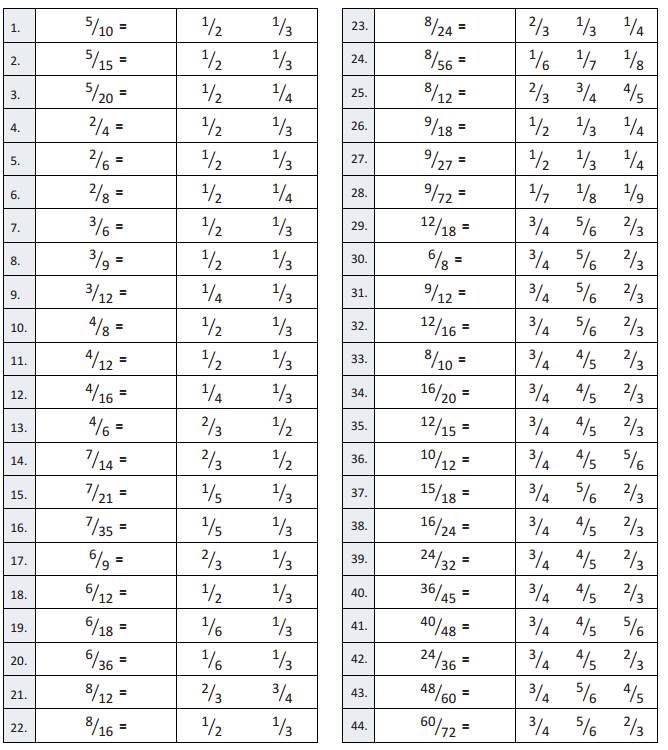
Question 1.
\(\frac{5}{10}\) = \(\frac{1}{2}\) \(\frac{1}{3}\)
Answer:
\(\frac{5}{10}\) = \(\frac{1}{2}\)
Explanation :
\(\frac{5}{10}\) when its numerator and denominator is divided by 5 we get \(\frac{1}{2}\)
Question 2.
\(\frac{5}{15}\) = \(\frac{1}{2}\) \(\frac{1}{3}\)
Answer:
\(\frac{5}{15}\) = \(\frac{1}{3}\)
Explanation :
\(\frac{5}{15}\) when its numerator and denominator is divided by 5 we get \(\frac{1}{3}\)
Question 3.
\(\frac{5}{20}\) = \(\frac{1}{2}\) \(\frac{1}{4}\)
Answer:
\(\frac{5}{20}\) = \(\frac{1}{4}\)
Explanation :
\(\frac{5}{20}\) when its numerator and denominator is divided by 5 we get \(\frac{1}{4}\)
Question 4.
\(\frac{2}{4}\) = \(\frac{1}{2}\) \(\frac{1}{3}\)
Answer:
\(\frac{2}{4}\) = \(\frac{1}{2}\)
Explanation :
\(\frac{2}{4}\) when its numerator and denominator is divided by 2 we get \(\frac{1}{2}\)
Question 5.
\(\frac{2}{6}\) = \(\frac{1}{2}\) \(\frac{1}{3}\)
Answer:
\(\frac{2}{6}\) = \(\frac{1}{3}\)
Explanation :
\(\frac{2}{6}\) when its numerator and denominator is divided by 2 we get \(\frac{1}{3}\)
Question 6.
\(\frac{2}{8}\) = \(\frac{1}{2}\) \(\frac{1}{4}\)
Answer:
\(\frac{2}{8}\) = \(\frac{1}{4}\)
Explanation :
\(\frac{2}{8}\) when its numerator and denominator is divided by 2 we get \(\frac{1}{4}\)
Question 7.
\(\frac{3}{6}\) = \(\frac{1}{2}\) \(\frac{1}{3}\)
Answer:
\(\frac{3}{6}\) = \(\frac{1}{2}\)
Explanation :
\(\frac{3}{6}\) when its numerator and denominator is divided by 3 we get \(\frac{1}{2}\)
Question 8.
\(\frac{3}{9}\) = \(\frac{1}{2}\) \(\frac{1}{3}\)
Answer:
\(\frac{3}{9}\) = \(\frac{1}{3}\)
Explanation :
\(\frac{3}{9}\) when its numerator and denominator is divided by 3 we get \(\frac{1}{3}\)
Question 9.
\(\frac{3}{12}\) = \(\frac{1}{4}\) \(\frac{1}{3}\)
Answer:
\(\frac{3}{12}\) = \(\frac{1}{4}\)
Explanation :
\(\frac{3}{12}\) when its numerator and denominator is divided by 3 we get \(\frac{1}{4}\)
Question 10.
\(\frac{4}{8}\) = \(\frac{1}{2}\) \(\frac{1}{3}\)
Answer:
\(\frac{4}{8}\) = \(\frac{1}{2}\)
Explanation :
\(\frac{4}{8}\) when its numerator and denominator is divided by 4 we get \(\frac{1}{2}\)
Question 11.
\(\frac{4}{12}\) = \(\frac{1}{2}\) \(\frac{1}{3}\)
Answer:
\(\frac{4}{12}\) = \(\frac{1}{3}\)
Explanation :
\(\frac{4}{12}\) when its numerator and denominator is divided by 4 we get \(\frac{1}{3}\)
Question 12.
\(\frac{4}{16}\) = \(\frac{1}{4}\) \(\frac{1}{3}\)
Answer:
\(\frac{4}{16}\) = \(\frac{1}{4}\)
Explanation :
\(\frac{4}{16}\) when its numerator and denominator is divided by 4 we get \(\frac{1}{4}\)
Question 13.
\(\frac{4}{6}\) = \(\frac{2}{3}\) \(\frac{1}{2}\)
Answer:
\(\frac{4}{6}\) = \(\frac{2}{3}\)
Explanation :
\(\frac{4}{6}\) when its numerator and denominator is divided by 2 we get \(\frac{2}{3}\)
Question 14.
\(\frac{7}{14}\) = \(\frac{2}{3}\) \(\frac{1}{2}\)
Answer:
\(\frac{7}{14}\) = \(\frac{1}{2}\)
Explanation :
\(\frac{7}{14}\) when its numerator and denominator is divided by 7 we get \(\frac{1}{2}\)
Question 15.
\(\frac{7}{21}\) = \(\frac{1}{5}\) \(\frac{1}{3}\)
Answer:
\(\frac{7}{21}\) = \(\frac{1}{3}\)
Explanation :
\(\frac{7}{21}\) when its numerator and denominator is divided by 7 we get \(\frac{1}{3}\)
Question 16.
\(\frac{7}{35}\) = \(\frac{1}{5}\) \(\frac{1}{3}\)
Answer:
\(\frac{7}{35}\) = \(\frac{1}{5}\)
Explanation :
\(\frac{7}{35}\) when its numerator and denominator is divided by 7 we get \(\frac{1}{5}\)
Question 17.
\(\frac{6}{9}\) = \(\frac{2}{3}\) \(\frac{1}{3}\)
Answer:
\(\frac{6}{9}\) = \(\frac{2}{3}\)
Explanation :
\(\frac{6}{9}\) when its numerator and denominator is divided by 3 we get \(\frac{2}{3}\)
Question 18.
\(\frac{6}{12}\) = \(\frac{1}{2}\) \(\frac{1}{3}\)
Answer:
\(\frac{6}{12}\) = \(\frac{1}{2}\)
Explanation :
\(\frac{6}{12}\) when its numerator and denominator is divided by 6 we get \(\frac{1}{2}\)
Question 19.
\(\frac{6}{18}\) = \(\frac{1}{6}\) \(\frac{1}{3}\)
Answer:
\(\frac{6}{18}\) = \(\frac{1}{3}\)
Explanation :
\(\frac{6}{18}\) when its numerator and denominator is divided by 6 we get \(\frac{1}{3}\)
Question 20.
\(\frac{6}{36}\) = \(\frac{1}{6}\) \(\frac{1}{3}\)
Answer:
\(\frac{6}{36}\) = \(\frac{1}{6}\)
Explanation :
\(\frac{6}{36}\) when its numerator and denominator is divided by 6 we get \(\frac{1}{6}\)
Question 21.
\(\frac{8}{12}\) = \(\frac{2}{3}\) \(\frac{3}{4}\)
Answer:
\(\frac{8}{12}\) = \(\frac{2}{3}\)
Explanation :
\(\frac{8}{12}\) when its numerator and denominator is divided by 4 we get \(\frac{2}{3}\)
Question 22.
\(\frac{8}{16}\) = \(\frac{1}{2}\) \(\frac{1}{3}\)
Answer:
\(\frac{8}{16}\) = \(\frac{1}{2}\)
Explanation :
\(\frac{8}{16}\) when its numerator and denominator is divided by 8 we get \(\frac{1}{2}\)
Question 23.
\(\frac{8}{24}\) = \(\frac{2}{3}\) \(\frac{1}{3}\) \(\frac{1}{4}\)
Answer:
\(\frac{8}{24}\) = \(\frac{1}{3}\)
Explanation :
\(\frac{8}{24}\) when its numerator and denominator is divided by 8 we get \(\frac{1}{3}\)
Question 24.
\(\frac{8}{56}\) = \(\frac{1}{6}\) \(\frac{1}{7}\) \(\frac{1}{8}\)
Answer:
\(\frac{8}{24}\) = \(\frac{1}{3}\)
Explanation :
\(\frac{8}{56}\) when its numerator and denominator is divided by 8 we get \(\frac{1}{7}\)
Question 25.
\(\frac{8}{12}\) = \(\frac{2}{3}\) \(\frac{3}{4}\) \(\frac{4}{5}\)
Answer:
\(\frac{8}{12}\) = \(\frac{2}{3}\)
Explanation :
\(\frac{8}{12}\) when its numerator and denominator is divided by 4 we get \(\frac{2}{3}\)
Question 26.
\(\frac{9}{18}\) = \(\frac{1}{2}\) \(\frac{1}{3}\) \(\frac{1}{4}\)
Answer:
\(\frac{9}{18}\) = \(\frac{1}{2}\)
Explanation :
\(\frac{9}{18}\) when its numerator and denominator is divided by 9 we get \(\frac{1}{2}\)
Question 27.
\(\frac{9}{27}\) = \(\frac{1}{2}\) \(\frac{1}{3}\) \(\frac{1}{4}\)
Answer:
\(\frac{9}{27}\) = \(\frac{1}{3}\)
Explanation :
\(\frac{9}{27}\) when its numerator and denominator is divided by 9 we get \(\frac{1}{3}\)
Question 28.
\(\frac{9}{72}\) = \(\frac{1}{7}\) \(\frac{1}{8}\) \(\frac{1}{9}\)
Answer:
\(\frac{9}{72}\) = \(\frac{1}{8}\)
Explanation :
\(\frac{9}{72}\) when its numerator and denominator is divided by 9 we get \(\frac{1}{8}\)
Question 29.
\(\frac{12}{18}\) = \(\frac{3}{4}\) \(\frac{5}{6}\) \(\frac{2}{3}\)
Answer:
\(\frac{12}{18}\) = \(\frac{2}{3}\)
Explanation :
\(\frac{12}{18}\) when its numerator and denominator is divided by 6 we get \(\frac{2}{3}\)
Question 30.
\(\frac{6}{8}\) = \(\frac{3}{4}\) \(\frac{5}{6}\) \(\frac{2}{3}\)
Answer:
\(\frac{6}{8}\) = \(\frac{3}{4}\)
Explanation :
\(\frac{6}{8}\) when its numerator and denominator is divided by 2 we get \(\frac{3}{4}\)
Question 31.
\(\frac{9}{12}\) = \(\frac{3}{4}\) \(\frac{5}{6}\) \(\frac{2}{3}\)
Answer:
\(\frac{9}{12}\) = \(\frac{3}{4}\)
Explanation :
\(\frac{9}{12}\) when its numerator and denominator is divided by 3 we get \(\frac{3}{4}\)
Question 32.
\(\frac{12}{16}\) = \(\frac{3}{4}\) \(\frac{5}{6}\) \(\frac{2}{3}\)
Answer:
\(\frac{12}{16}\) = \(\frac{3}{4}\)
Explanation :
\(\frac{12}{16}\) when its numerator and denominator is divided by 4 we get \(\frac{3}{4}\)
Question 33.
\(\frac{8}{10}\) = \(\frac{3}{4}\) \(\frac{4}{5}\) \(\frac{2}{3}\)
Answer:
\(\frac{8}{10}\) = \(\frac{4}{5}\)
Explanation :
\(\frac{8}{10}\) when its numerator and denominator is divided by 2 we get \(\frac{4}{5}\)
Question 34.
\(\frac{16}{20}\) = \(\frac{3}{4}\) \(\frac{4}{5}\) \(\frac{2}{3}\)
Answer:
\(\frac{16}{20}\) = \(\frac{4}{5}\)
Explanation :
\(\frac{16}{20}\) when its numerator and denominator is divided by 4 we get \(\frac{4}{5}\)
Question 35.
\(\frac{12}{15}\) = \(\frac{3}{4}\) \(\frac{4}{5}\) \(\frac{2}{3}\)
Answer:
\(\frac{12}{15}\) = \(\frac{4}{5}\)
Explanation :
\(\frac{12}{15}\) when its numerator and denominator is divided by 3 we get \(\frac{4}{5}\)
Question 36.
\(\frac{10}{12}\) = \(\frac{3}{4}\) \(\frac{4}{5}\) \(\frac{5}{6}\)
Answer:
\(\frac{10}{12}\) = \(\frac{5}{6}\)
Explanation :
\(\frac{10}{12}\) when its numerator and denominator is divided by 2 we get \(\frac{5}{6}\)
Question 37.
\(\frac{15}{18}\) = \(\frac{3}{4}\) \(\frac{5}{6}\) \(\frac{2}{3}\)
Answer:
\(\frac{15}{18}\) = \(\frac{5}{6}\)
Explanation :
\(\frac{15}{18}\) when its numerator and denominator is divided by 3 we get \(\frac{5}{6}\)
Question 38.
\(\frac{16}{24}\) = \(\frac{3}{4}\) \(\frac{4}{5}\) \(\frac{2}{3}\)
Answer:
\(\frac{16}{24}\) = \(\frac{2}{3}\)
Explanation :
\(\frac{16}{24}\) when its numerator and denominator is divided by 8 we get \(\frac{2}{3}\)
Question 39.
\(\frac{24}{32}\) = \(\frac{3}{4}\) \(\frac{4}{5}\) \(\frac{2}{3}\)
Answer:
\(\frac{24}{32}\) = \(\frac{3}{4}\)
Explanation :
\(\frac{24}{32}\) when its numerator and denominator is divided by 12 we get \(\frac{3}{4}\)
Question 40.
\(\frac{36}{45}\) = \(\frac{3}{4}\) \(\frac{4}{5}\) \(\frac{2}{3}\)
Answer:
\(\frac{36}{45}\) = \(\frac{4}{5}\)
Explanation :
\(\frac{36}{45}\) when its numerator and denominator is divided by 9 we get \(\frac{4}{5}\)
Question 41.
\(\frac{40}{48}\) = \(\frac{3}{4}\) \(\frac{4}{5}\) \(\frac{5}{6}\)
Answer:
\(\frac{40}{48}\) = \(\frac{5}{6}\)
Explanation :
\(\frac{40}{48}\) when its numerator and denominator is divided by 8 we get \(\frac{5}{}\)
Question 42.
\(\frac{24}{36}\) = \(\frac{3}{4}\) \(\frac{4}{5}\) \(\frac{2}{3}\)
Answer:
\(\frac{24}{36}\) = \(\frac{2}{3}\)
Explanation :
\(\frac{24}{36}\) when its numerator and denominator is divided by 12 we get \(\frac{2}{3}\)
Question 43.
\(\frac{48}{60}\) = \(\frac{3}{4}\) \(\frac{5}{6}\) \(\frac{4}{5}\)
Answer:
\(\frac{48}{60}\) = \(\frac{4}{5}\)
Explanation :
\(\frac{48}{60}\) when its numerator and denominator is divided by 12 we get \(\frac{4}{5}\)
Question 44.
\(\frac{60}{72}\) = \(\frac{3}{4}\) \(\frac{5}{6}\) \(\frac{2}{3}\)
Answer:
\(\frac{60}{72}\) = \(\frac{5}{6}\)
Explanation :
\(\frac{60}{72}\) when its numerator and denominator is divided by 12 we get \(\frac{5}{6}\)
Eureka Math Grade 5 Module 3 Lesson 7 Problem Set Answer Key
Solve the word problems using the RDW strategy. Show all of your work.
Question 1.
George weeded \(\frac{1}{5}\) of the garden, and Summer weeded some, too. When they were finished, \(\frac{2}{3}\) of the garden still needed to be weeded. What fraction of the garden did Summer weed?
Answer:
Total Garden = 1 whole .
Fraction of garden weeded by George = \(\frac{1}{5}\)
Fraction of garden needed to be weeded = \(\frac{2}{3}\)
Fraction of garden weeded by summer = x
1 = \(\frac{1}{5}\) + x + \(\frac{2}{3}\)
x = 1 – \(\frac{1}{5}\) – \(\frac{2}{3}\)
lcm of 5 and 3 is 15.
x = \(\frac{15}{15}\) – \(\frac{3}{15}\) – \(\frac{10}{15}\)
x = \(\frac{15}{15}\) – \(\frac{13}{15}\)
x = \(\frac{2}{15}\)
Therefore , Fraction of garden weeded by summer = x = \(\frac{2}{15}\)
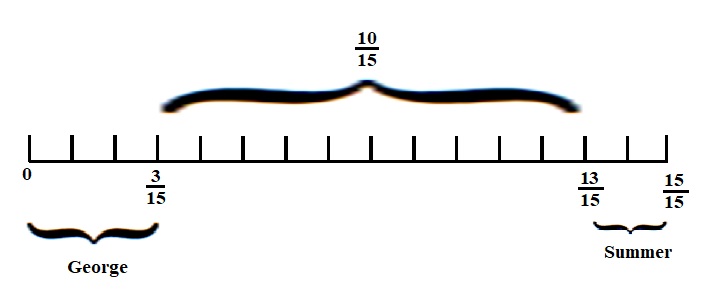
Question 2.
Jing spent \(\frac{1}{3}\) of her money on a pack of pens, \(\frac{1}{2}\) of her money on a pack of markers, and \(\frac{1}{8}\) of her money on a pack of pencils. What fraction of her money is left?
Answer:
Total Money = 1
Money spent on pack of pens = \(\frac{1}{3}\)
Money spent on pack of markers = \(\frac{1}{2}\)
Money spent on pack of pencils = \(\frac{1}{8}\)
Fraction of Money left = x
1 = \(\frac{1}{3}\) + \(\frac{1}{2}\) + \(\frac{1}{8}\) + x
lcm of 3, 2 and 8 is 24
\(\frac{24}{24}\) = \(\frac{8}{24}\) + \(\frac{12}{24}\) + \(\frac{3}{24}\) + x
\(\frac{24}{24}\) = \(\frac{23}{24}\) + x
x = \(\frac{24}{24}\) – \(\frac{23}{24}\)
x = \(\frac{1}{24}\) .
Therefore, Fraction of Money left = \(\frac{1}{24}\)
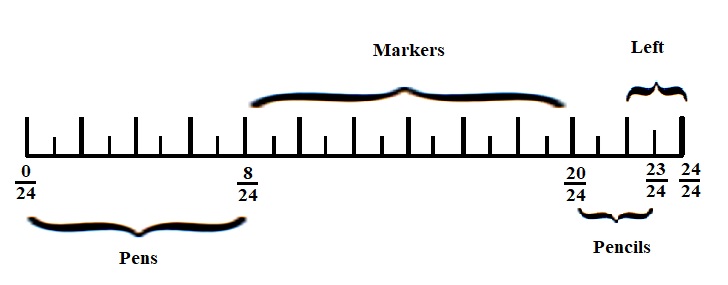
Question 3.
Shelby bought a 2-ounce tube of blue paint. She used \(\frac{2}{3}\) ounce to paint the water, \(\frac{3}{5}\) ounce to paint the sky, and some to paint a flag. After that, she has \(\frac{2}{15}\) ounce left. How much paint did Shelby use to paint her flag?
Answer:
Quantity of Blue paint = 2 – ounce
Fraction of blue paint used for painting water = \(\frac{2}{3}\)
Fraction of blue paint used for painting sky = \(\frac{3}{5}\)
Fraction of blue paint used for painting flag = x
Fraction of blue paint left = \(\frac{2}{15}\)
2 = \(\frac{2}{3}\) + \(\frac{3}{5}\) + x + \(\frac{2}{15}\)
lcm of 3, 5 and 15 is 15 .
\(\frac{30}{15}\) = \(\frac{10}{15}\) + \(\frac{9}{15}\) + x + \(\frac{2}{15}\)
\(\frac{30}{15}\) = \(\frac{21}{15}\) + x
x = \(\frac{30}{15}\) – \(\frac{21}{15}\)
x = \(\frac{9}{15}\) = \(\frac{3}{5}\)
Therefore , Fraction of blue paint used for painting flag = x = \(\frac{9}{15}\) = \(\frac{3}{5}\) .ounce
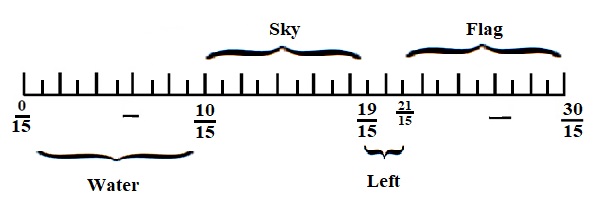
Question 4.
Jim sold \(\frac{3}{4}\) gallon of lemonade. Dwight sold some lemonade, too. Together, they sold 1\(\frac{5}{12}\) gallons. Who sold more lemonade, Jim or Dwight? How much more?
Answer:
Fraction of lemonade sold by Jim = \(\frac{3}{4}\) gallon
Fraction of lemonade sold by Dwight = x gallon
Fraction of lemonade sold by Jim and Dwight = 1\(\frac{5}{12}\) gallon
1\(\frac{5}{12}\) = \(\frac{3}{4}\) + x
x = 1\(\frac{5}{12}\) – \(\frac{3}{4}\)
lcm of 12 and 4 is 12 .
x = \(\frac{17}{12}\) – \(\frac{9}{12}\)
x = \(\frac{8}{12}\) = \(\frac{2}{3}\)
Therefore, Fraction of lemonade sold by Dwight = x = \(\frac{8}{12}\) = \(\frac{2}{3}\) gallon .
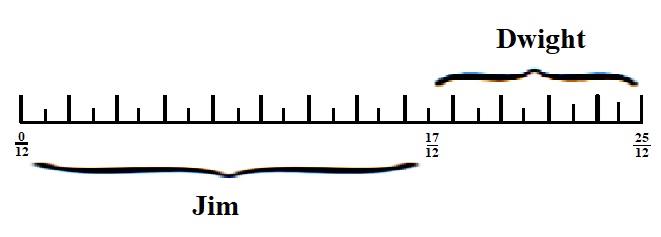
Question 5.
Leonard spent \(\frac{1}{4}\) of his money on a sandwich. He spent 2 times as much on a gift for his brother as on some comic books. He had \(\frac{3}{8}\) of his money left. What fraction of his money did he spend on the comic books?
Answer:
Fraction of Money spent on sandwich = \(\frac{1}{4}\)
Fraction of money left with him = \(\frac{3}{8}\)
Total Money = 1
1 = \(\frac{1}{4}\) + \(\frac{3}{8}\) + x .
Lcm of 4 and 8 is 8.
\(\frac{8}{8}\) = \(\frac{2}{8}\) + \(\frac{3}{8}\) + x
\(\frac{8}{8}\) = \(\frac{5}{8}\) + x
x = \(\frac{8}{8}\) – \(\frac{5}{8}\)
x = \(\frac{3}{8}\)
Fraction of Money spent on his brother = \(\frac{2}{8}\) = \(\frac{1}{4}\)
Fraction of Money spent on Comic books = \(\frac{1}{8}\) .
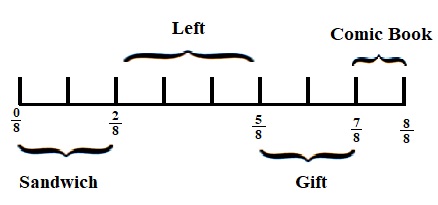
Eureka Math Grade 5 Module 3 Lesson 7 Exit Ticket Answer Key
Solve the word problem using the RDW strategy. Show all of your work.
Mr. Pham mowed \(\frac{2}{7}\) of his lawn. His son mowed \(\frac{1}{4}\) of it. Who mowed the most? How much of the lawn still needs to be mowed?
Answer:
Fraction Of Lawn mowed by Mr.Pham = \(\frac{2}{7}\)
Fraction Of Lawn mowed by his Son = \(\frac{1}{4}\)
lcm of 7 and 4 is 28 .
\(\frac{2}{7}\) = \(\frac{8}{28}\)
\(\frac{1}{4}\) = \(\frac{7}{28}\)
\(\frac{8}{28}\) > \(\frac{7}{28}\)
Mr. Pham mowed most than his son .
Fraction of lawn still needed to mowed = x
1= \(\frac{8}{28}\) + \(\frac{7}{28}\) + x
\(\frac{28}{28}\) = \(\frac{15}{28}\) + x
x = \(\frac{28}{28}\) – \(\frac{15}{28}\)
x = \(\frac{13}{28}\)
Therefore, Fraction of lawn still needed to mowed = x = \(\frac{13}{28}\) .
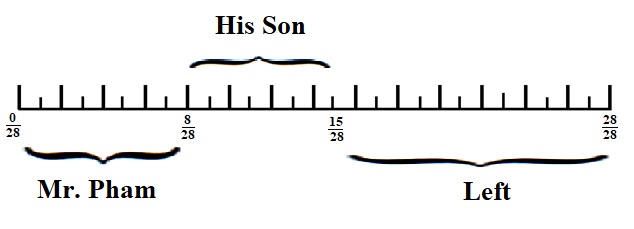
Eureka Math Grade 5 Module 3 Lesson 7 Homework Answer Key
Solve the word problems using the RDW strategy. Show all of your work.
Question 1.
Christine baked a pumpkin pie. She ate \(\frac{1}{6}\) of the pie. Her brother ate \(\frac{1}{6}\) of it and gave the leftovers to his friends. What fraction of the pie did he give to his friends?
Answer:
Total pie = 1 .
Fraction of pie ate by Christine = \(\frac{1}{6}\)
Fraction of pie ate by her Brother =\(\frac{1}{6}\)
Fraction of pie leftover to her friends = x
1 = \(\frac{1}{6}\) + \(\frac{1}{6}\) + x
lcm is 6
\(\frac{6}{6}\) = \(\frac{2}{6}\) + x
x = \(\frac{6}{6}\) – \(\frac{2}{6}\)
x = \(\frac{4}{6}\) = \(\frac{2}{3}\)
Therefore, Fraction of pie leftover to her friends = x = \(\frac{4}{6}\) = \(\frac{2}{3}\) .
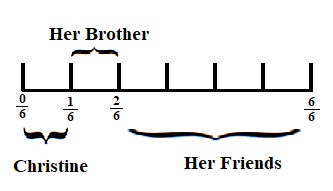
Question 2.
Liang went to the bookstore. He spent \(\frac{1}{3}\) of his money on a pen and \(\frac{4}{7}\) of it on books. What fraction of his money did he have left?
Answer:
Total money = 1
Fraction of Money spent on Pen =\(\frac{1}{3}\)
Fraction of Money spent on Books =\(\frac{4}{7}\)
Fraction of Money left = x
1 = \(\frac{1}{3}\) + \(\frac{4}{7}\) + x
lcm of 3 and 7 is 21 .
\(\frac{21}{21}\) = \(\frac{7}{21}\) + \(\frac{12}{21}\) + x
\(\frac{21}{21}\) = \(\frac{19}{21}\) + x
x = \(\frac{3}{21}\) = \(\frac{1}{7}\) .
Therefore, Fraction of Money left = x = \(\frac{3}{21}\) = \(\frac{1}{7}\) .
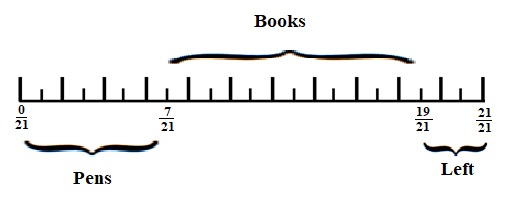
Question 3.
Tiffany bought \(\frac{2}{5}\) kg of cherries. Linda bought \(\frac{1}{10}\) kg of cherries less than Tiffany. How many kilograms of cherries did they buy altogether?
Answer:
Fraction of Quantity of Cherries bought by Tiffany = \(\frac{2}{5}\) kg
Fraction of Quantity of Cherries bought by Linda = x kg
Fraction of Quantity of cherries Linda bought \(\frac{1}{10}\) kg of cherries less than Tiffany.
Fraction of Quantity of Cherries bought by Linda = x = \(\frac{2}{5}\) – \(\frac{1}{10}\)
lcm of 2 and 5 is 10 .
x = \(\frac{4}{10}\) – \(\frac{1}{10}\)
x = \(\frac{3}{10}\)
Fraction of Quantity of cherries bought by both = \(\frac{2}{5}\) + \(\frac{3}{10}\) = \(\frac{4}{10}\) + \(\frac{3}{10}\) = \(\frac{7}{10}\)
Therefore, Fraction of Quantity of cherries bought by both = \(\frac{7}{10}\)
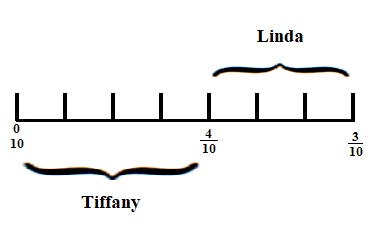
Question 4.
Mr. Rivas bought a can of paint. He used \(\frac{3}{8}\) of it to paint a bookshelf. He used \(\frac{1}{4}\) of it to paint a wagon. He used some of it to paint a birdhouse and has \(\frac{1}{8}\) of the paint left. How much paint did he use for the birdhouse?
Answer:
Fraction of paint used to paint a bookshelf = \(\frac{3}{8}\)
Fraction of paint used to paint a wagon = \(\frac{1}{4}\)
Fraction of paint used to paint a birdhouse = x
Fraction of paint left = \(\frac{1}{8}\)
Total paint = 1 .
1 = \(\frac{3}{8}\) + \(\frac{1}{4}\) + x + \(\frac{1}{8}\)
lcm of 4 and 8 is 8 .
\(\frac{8}{8}\) = \(\frac{3}{8}\) +\(\frac{2}{8}\) + x + \(\frac{1}{8}\)
\(\frac{8}{8}\) = \(\frac{6}{8}\) + x
x = \(\frac{8}{8}\) – \(\frac{6}{8}\)
x = \(\frac{2}{8}\) = \(\frac{1}{4}\) .
Therefore, Fraction of paint used to paint a bird house = x = \(\frac{2}{8}\) = \(\frac{1}{4}\)
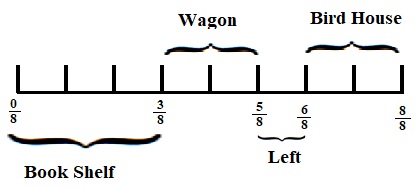
Question 5.
Ribbon A is \(\frac{1}{3}\) m long. It is \(\frac{2}{5}\) m shorter than Ribbon B. What’s the total length of the two ribbons?
Answer:
Fraction of length of Ribbon A = \(\frac{1}{3}\) m
Fraction of length of Ribbon A = Fraction of length of Ribbon B – \(\frac{2}{5}\) m
Fraction of length of Ribbon B = \(\frac{1}{3}\) + \(\frac{2}{5}\)
lcm of 3 and 5 is 15 .
Fraction of length of Ribbon B = \(\frac{1}{3}\) + \(\frac{2}{5}\) = \(\frac{5}{15}\) + \(\frac{6}{15}\) = \(\frac{11}{15}\)
Fraction of Total Length of two ribbons = \(\frac{1}{3}\) + \(\frac{11}{15}\) = \(\frac{5}{15}\) + \(\frac{11}{15}\) = \(\frac{16}{15}\) m .
Therefore, Fraction of Total Length of two ribbons =\(\frac{16}{15}\) m
